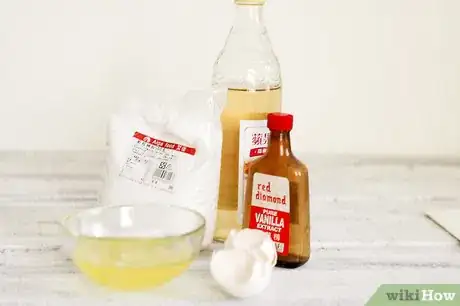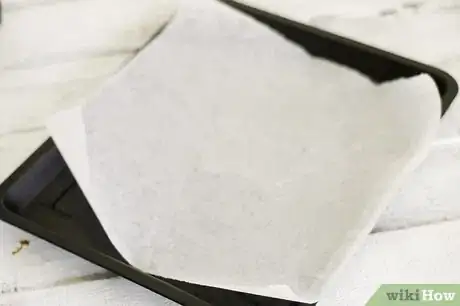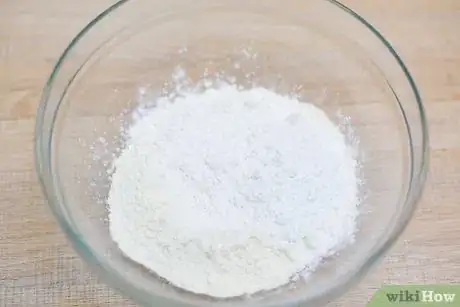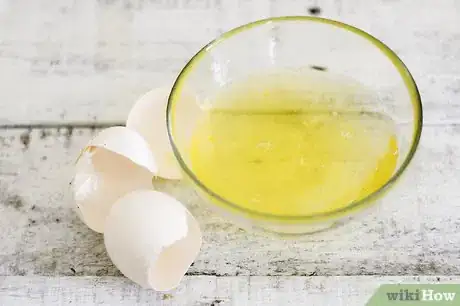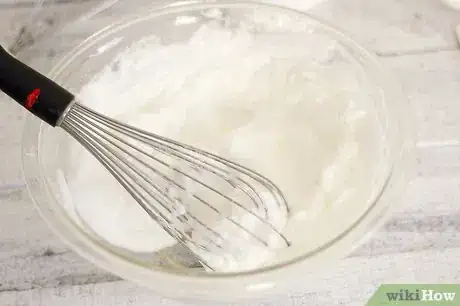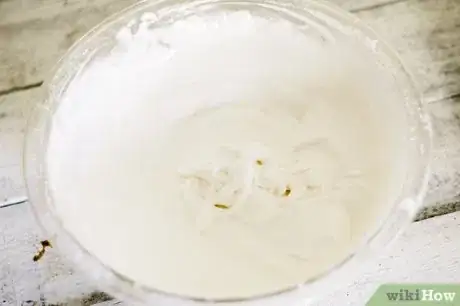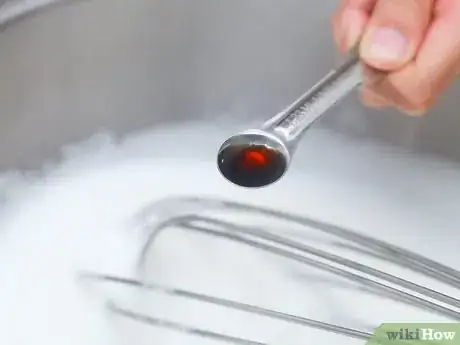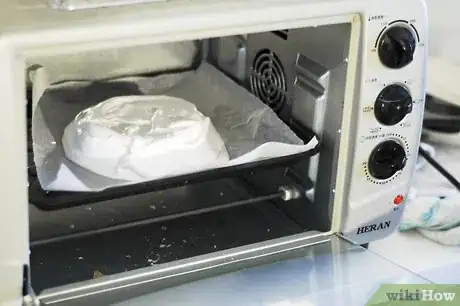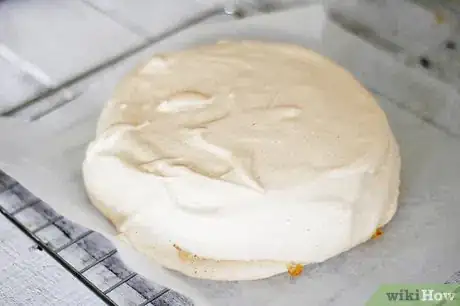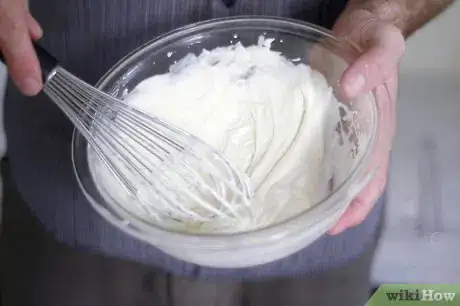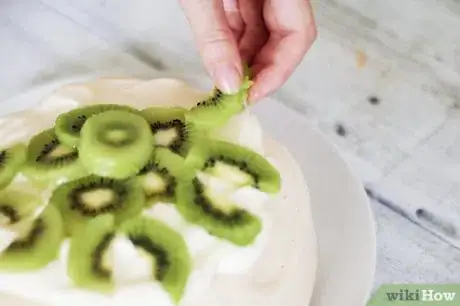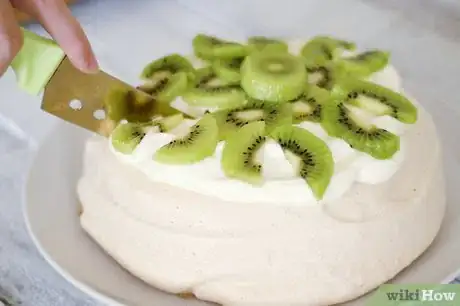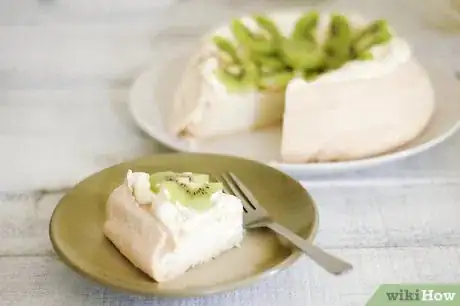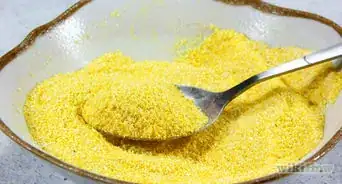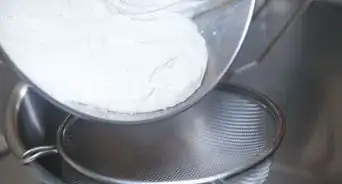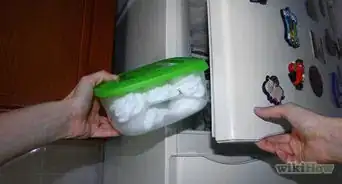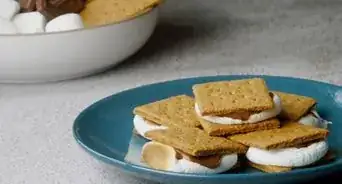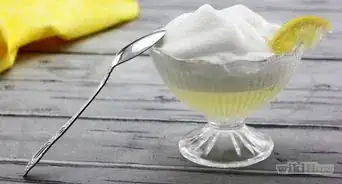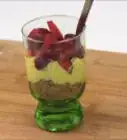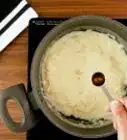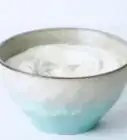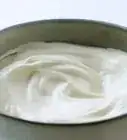This article was co-authored by wikiHow Staff. Our trained team of editors and researchers validate articles for accuracy and comprehensiveness. wikiHow's Content Management Team carefully monitors the work from our editorial staff to ensure that each article is backed by trusted research and meets our high quality standards.
wikiHow marks an article as reader-approved once it receives enough positive feedback. In this case, 80% of readers who voted found the article helpful, earning it our reader-approved status.
This article has been viewed 194,290 times.
Learn more...
Pavlova is a light, airy meringue topped with fruit slices and whipped cream. Legend says that it was created in honor of Russian ballerina Anna Pavlova on her visit to Australia and New Zealand for a ballet tour early in the 20th century. This creamy dessert is the perfect end to a summer's meal. See Step 1 to learn how to make it.
Ingredients
- 4 egg whites
- 1 cup caster sugar (super fine white sugar)
- 1 teaspoon white vinegar
- 1/2 tablespoon cornstarch
- 1 teaspoon vanilla extract
- 1 cup heavy cream
- 1 tablespoon sugar
- 2 cups sliced fruit such as strawberries or kiwifruit
Steps
Making the Meringue for the Base
-
1Assemble the ingredients. Pavlova has very few ingredients, but each one is very important. Don't make substitutions for any of the ingredients, since the texture of the dessert depends on the precise chemistry of each one.
-
2Preheat the oven to 275 °F (135 °C). Arrange a rack in the lower third of the oven.Advertisement
-
3Prepare a baking sheet. Tear off a large sheet of parchment paper and place it on a baking sheet. Trace around the bottom of a 9-inch cake pan to draw a circle on the parchment paper. You'll spread the meringue mixture inside the circle to bake it.[1]
-
4Mix the sugar and cornstarch in a small bowl. If you'd like, add a pinch of salt as well.
-
5Separate the egg whites from the yolks. It's very important to make sure the egg whites don't get tainted by bits of yolk; this will prevent your meringue from stiffening.
- Make sure you pour the whites into a very clean, dry metal mixing bowl. Water or bits of oil will affect the texture of your meringue.
- Keep the yolks for a different recipe, or make an omelette later.
-
6Beat the egg whites. Use with a hand mixer on high speed for about 5 minutes, or beat with an egg whisk, until soft peaks form.
-
7Add the castor sugar mixture by the teaspoonful. Keep beating the egg whites and add the sugar mixture teaspoon by teaspoon. Continue until you run out of sugar and the whites have formed stiff, glossy peaks.
-
8Add the vinegar and vanilla. Pour the vinegar and vanilla over the peaks and keep beating until everything is mixed together. The vinegar will help the meringue stay crispy around the edges and soft in the middle as it bakes.
Baking the Meringue
-
1Spoon the mixture into the parchment circle. Use the back of the spoon to spread it evenly. It should be approximately dinner plate roundness in size.
-
2Create a small indented hollow in the centre. Pavlovas should be round with a little hollow that takes the cream and topping, so it helps to imagine that you're making a nest shape with slightly raised edges.
- If your shape is on the oblong side of circular, don't worry too much about how accurate the circular shape is - creative misshapes are permissible as long as the topping stays put.
-
3Bake the meringue. Place it in the oven and cook for 60-70 minutes, or until crisp. Don't let the meringue over-brown; it should be an off-white color on the outside when it's ready.
-
4Remove the pavlova from the oven. Place it on a wire rack to cool. Transfer it to a serving dish and prepare to add the toppings. Allow the meringue to cool completely before finishing the dish.
- There's a tradition to turn the pavlova over and decorate the base because it is said that this side is less crisp. Sometimes this reason is actually a nifty cover-up trick for little cooking mistakes like over-browning the top. Either way, the pavlova centre will quickly lose its initial crispness anyway because of the whipped cream and topping.
Finishing the Pavlova with the Topping
-
1Prepare the toppings. Whip the cream and sugar until the cream forms soft peaks. Slice the strawberries and kiwis or other fruit toppings. If there's time left, research the origins of the pavlova and make up your own mind about who invented it.
-
2Add the whipped cream. Spread it evenly to the edges of the meringue. Use the cream to fill in cracks and cover other imperfections.
- You can also flavor the cream if you'd like - try a teaspoon of vanilla extract, rosewater, orange water, lemon extract, or almond extract.
- Although whipped cream is traditional, you might like to vary the whipped cream with other soft creamy like substances such as custard. This would be frowned upon by traditionalists but experimental cooks have creative license.
-
3Arrange the fruit on top.[2] Lay the strawberry or kiwi slices in a pretty pattern over the whipped cream. Another popular tradition is to drizzle freshly opened passionfruit over the top of the pavlova.
- Other topping ideas include a mixture of berries, sliced cherries, apricots, mangoes or peaches, grated dark chocolate, or a mixture of chocolate and raspberries.
-
4Serve the pavlova. The beauty of a pavlova is in the eye of the creator; everyone else just wants to eat it. Don't be surprised at how quickly your creation disappears.
-
5Finished.
Community Q&A
-
QuestionHow do I stop a pavlova from cracking?
 Vivi FCommunity AnswerDon't overbeat your mixture. Use eggs with a room temperature as cold eggs take longer to beat, then only beat your eggs until the sugar dissolves.
Vivi FCommunity AnswerDon't overbeat your mixture. Use eggs with a room temperature as cold eggs take longer to beat, then only beat your eggs until the sugar dissolves. -
QuestionCan I make it without cornstarch?
 Community AnswerNo, the starch gives the Pavlova its substance, it's the binding agent. You cannot substitute it with flour, as that is usually not ground as fine as starch.
Community AnswerNo, the starch gives the Pavlova its substance, it's the binding agent. You cannot substitute it with flour, as that is usually not ground as fine as starch. -
QuestionDo I have to use just the white of the egg?
 Community AnswerYes. You never want egg yolks to fall into the batter; even a tiny amount of yolk will affect your pavlova.
Community AnswerYes. You never want egg yolks to fall into the batter; even a tiny amount of yolk will affect your pavlova.
Warnings
- If it burns, cut off the burned bits and slather the remaining pavlova with cream and topping. If it sinks, slather it with cream and topping. While the ideal pavlova is symmetrical, balanced and clear of flaws, unless you're a chef, this is a very forgiving dessert and as long as it still tastes good, people won't really notice.⧼thumbs_response⧽
- Disasters that may befall a pavlova include: Browned too much from overcooking; burning because you forgot to take it out on time; or sinking because you got impatient and opened the door too soon. If it is overbrowned, it'll probably be chewy - but there are people who like it chewy; just slather on lots of cream and topping.⧼thumbs_response⧽
- Never bring up the question of who invented the pavlova at a dinner party containing both Australians and New Zealanders. Most likely it will result in a huge dispute.⧼thumbs_response⧽
- If it is completely burned, crumbly, or sunken, compost it and start again. If all else fails, run down to your local supermarket - most Australian and New Zealand supermarkets stock pre-made pavlova cases in their bakery section.⧼thumbs_response⧽
References
About This Article
To make pavlova, start by combining corn starch and sugar, then beat it into 4 egg whites 1 teaspoon at a time. When the mixture develops stiff peaks, mix in the vinegar and vanilla. Pour the mixture into a round tray covered with parchment paper and make an indent in the middle for the topping to sit in later, then bake the meringue at 270 degrees F for 60-70 minutes. Allow the pavlova to cool on a wire rack before spreading the whipped cream on top. Finish by topping your pavlova with strawberries or kiwi slices. For tips on how to separate egg whites and other topping ideas, read on!
